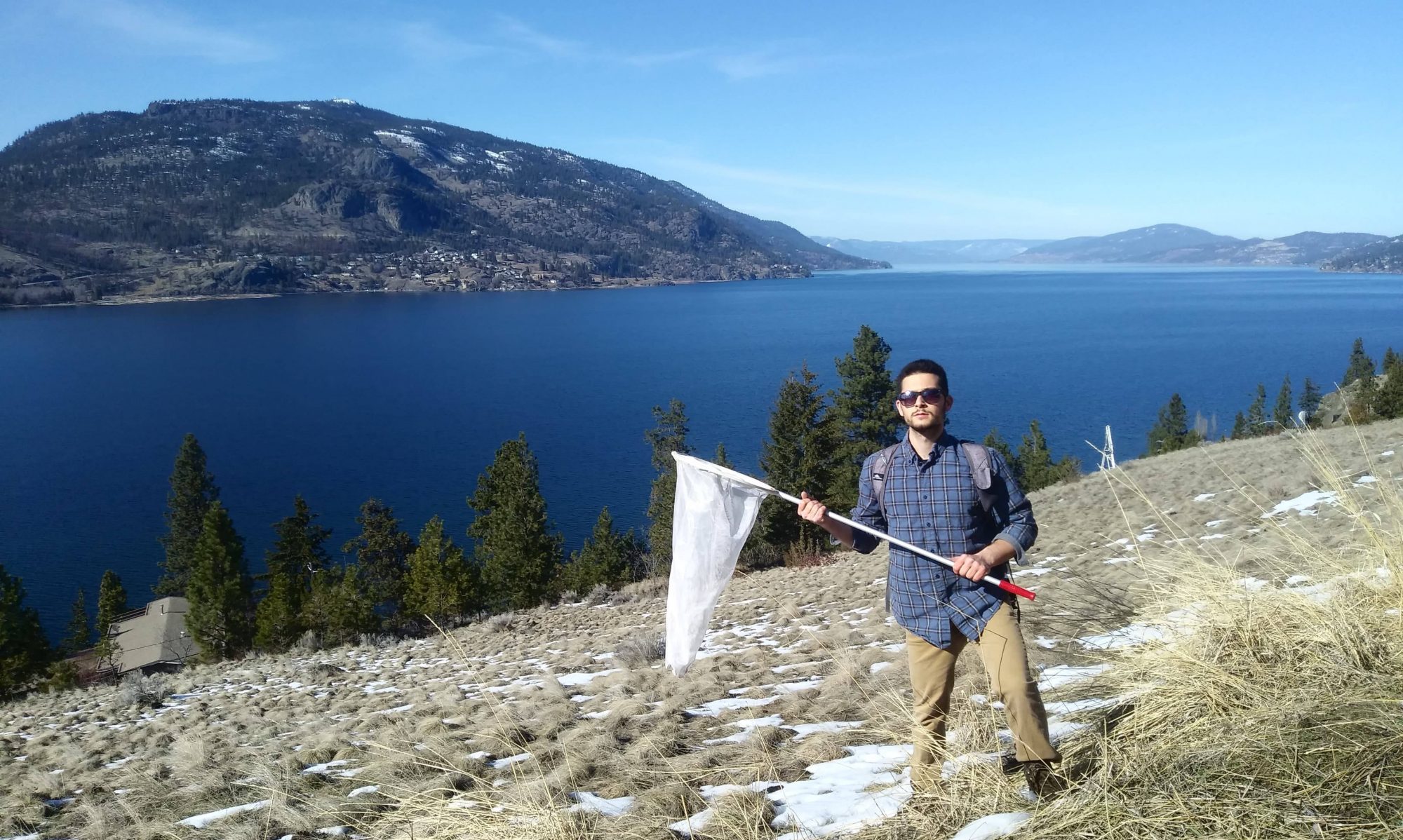My current research is being undertaken as part of my MSc, and development of this project began in September 2018. I am currently working under the supervision of Dr. Jason Pither of UBC Okanagan,
A final proposal will be completed in April 2019, with in-field research expected to begin in late April or early May.
Introduction
Pollinators, insects that pollinate flowering plants, are of key importance to the survival of many ecosystems and are particularly relevant to human life, as they play critical roles in the production of many crop species (Wratten et al., 2012). In fact, pollinators are responsible for about two-thirds of flowering plant populations (Environmental Youth Alliance, 2013) and 80% of wild plant species rely directly on insect pollination (Potts et al., 2010).
While bees and other species of pollinator play such vital roles in the food systems of the planet, they have faced many challenges in the wake of human development activities. Overall, these species have seen noticeable declines in their populations, and this trend can be attributed to many factors. The contributing factors to the decline of pollinator species include degradation and fragmentation of their habitats, the loss of flower-rich plant communities vital to the health of these populations, the continued and increased use of pesticides in agriculture, and an increased spread of pathogens and parasites (Wratten et al., 2012).
Urban areas and the processes of urbanization in particular have the potential to impose detrimental ecological impacts on the resident species of affected areas. For pollinating species, urbanization results in changes in available nesting sites, and as these tend to become fewer and more inaccessible, the accessibility and quality of food plants also decline (Kearns and Oliveiras, 2009).
Cities can actually provide a variety of forage and nesting sites for pollinators, and can act as a refuge for these species (Hall et al., 2017; Hennig and Ghazoul, 2012). Urban areas can be acceptable habitats for many different species of pollinator, especially generalist species that can forage on various plant resources (Somme et al., 2016).
Fragmented green spaces within urban environments, including home and community gardens, road edges and flower beds can supply these nesting sites and resources for pollinating species in an otherwise unsuitable environment (Tommasi et al., 2004). Urban parks, relative to the theory of island biogeography, can act as islands of suitable habitat surrounded by unsuitable anthropogenic space (McFrederick and LeBuhn, 2006). Urban gardens, while their benefits will differ between areas (Bates et al., 2011), are especially important to bees and other pollinators within urban areas, as these gardens act to support bees and other pollinating species by providing resources in areas that tend to be resource-poor (Pardee and Philpott, 2014).
The mitigation of threats facing insect pollinators and the services they provide has become an increasingly relevant issue for both policy and the public. Many initiatives have been introduced to understand the risks posed to urban pollinators and how these risks can be minimized to allow for sustainable population services at all scales (Gill et al., 2016). In order to properly manage urban pollinator habitat, it is crucial to know not only how to improve habitat quality, but also how to most effectively connect high quality patches of habitat for the benefit of pollinator species. It is necessary to know how to do this effectively, as species richness and the maintenance of viable pollinator populations are dependent on a high level of habitat connectivity (Gill et al., 2016).
These mitigation strategies are happening in our own backyards here in the Okanagan. Initiatives are currently in place in Kelowna to foster healthy populations of native urban bee and improve the habitat connectivity of these species throughout the city.
Border Free Bees
The Border Free Bees initiative, spearheaded by Nancy Holmes and Cameron Cartiere, is a long-term public art initiative aiming to, through collaboration with various community partners:
- Raise awareness of the threats posed to wild pollinators
- Engage communities in the mitigation of habitat loss
- Create through the conversion of under-utilized urban sites (Border Free Bees, 2015).
There are various projects associated with this initiative, each attempting to address issues of pollinator habitat fragmentation throughout the city. The Kelowna Nectar Trail Project, which began in 2017, involved a large effort to improve the connectivity of pollinator habitat throughout the city. This project was mainly focused on the improvement of native bee habitat connectivity across the Mission area of Kelowna. An initial 101 properties, including private homes, schools, businesses and more, signed up for the program (the trail itself spanning an area of 7.4km), becoming “bee ambassadors” in the process (Border Free Bees, 2017).
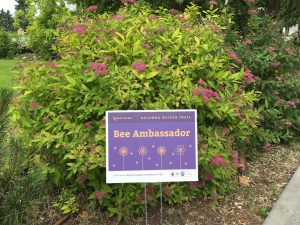
(Border Free Bees, 2017)
To become a bee ambassador, participants in the program must plant and maintain a garden of at least one square-meter containing pollinator-friendly flowers. In addition, the flower selections they choose must be drought-tolerant, pesticide-free and have a blooming range from spring to fall. Ambassadors must also ensure that bare spots are left in their garden to supply habitat for wild bees. Ambassadors in the city can be identified by the presence of a sign on their property that indicates their commitment to the project. The Bee Ambassador Program took off in 2018, building on the original Nectar Trail project with more than 350 properties across the city joining the program alongside the 2017 participants (Border Free Bees, 2018).
A map featuring the geographic location of each property involved in the program (for which the property owner agreed to have have their location shown) is available on the Border Free Bees website, with data also present on the specific location of each property. The vast majority of participants are private homes, however a wide range of property types have taken on the commitment to protect native bees
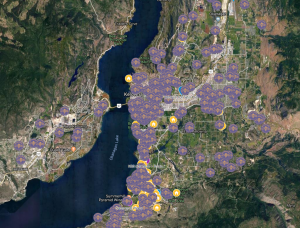
(Border Free Bees, 2018)
Locations of bee ambassador properties can be seen in purple
There is currently an extensive network of bee-friendly habitat within the city, thanks to the involvement of these ambassadors and the efforts of Border Free Bees to recruit these. As the impact of this program within Kelowna has been such a success and has seen the involvement of hundreds of members of the community, the shear number of ambassador gardens throughout the city as a result of this program could greatly affect the diversity and abundance of many native bee species in the area. The functional characteristics of bees within an urban setting in the Okanagan have not yet been examined, and the degree to which the current efforts of the Border Free Bees initiative are contributing to the diversity of bees within Kelowna is a worthwhile study.
Potential research question:
How are the structural characteristics of urban “Bee Ambassador” gardens associated with bee abundance and diversity during the peak season in the Okanagan?
For the purposes of my study, a series of steps will need to be taken in the site selection process, the first of which will involve looking through the online map of bee ambassador sites. From this data, I will compile a list of sites that I am keen on sampling from through my fieldwork. A subset of these will be chosen to be examined within my study.
As the vast majority of sites will be private properties, I will need to obtain permission from landowners to sample from their gardens prior to the finalization of my research sites.
Once sites have been chosen and permission obtained, an inventory of the characteristics of each garden will be taken, in which several key variables will be examined. These will include:
- Total area of the garden,
- Proportion of a garden containing native vegetation,
- Area of impermeable ground with a 300m radius,
- Tree cover within a 300m radius
- Number of other ambassador gardens within a 300m radius
The above characteristics will be recorded using a combination of geospatial techniques and in-field measurements.
Proposed Fieldwork
To obtain in-field measures of bee diversity and abundance at each of the sites sampled from, a couple of methods will be used.
I will be collecting bees using a sweep net within a designated transect.
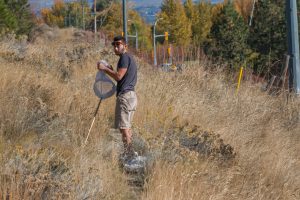
(Lalonde, 2018)
An attempt will be made to avoid killing as many collected bees as possible, through the use of a reference collection of native bees to assist in on-site identification of caught specimens.
As part of a directed studies course in my degree at UBC Okanagan, I will be completing a reference collection of native bees in the Okanagan in addition to the field work that is part of this study. This will involve the collection of various species of bee from early spring to late summer. The bees that I collect as part of this process will be placed into a killing jar, an empty glass jar with a foam pad at the bottom. A small amount of ethyl acetate will be applied to the foam pad, the scent of which will act to kill the bees within a short time period. Caught bees will then be brought back to the lab, where they will be pinned and identified to species.
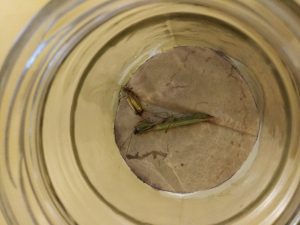
Insects sit on a pad at the bottom of a killing jar
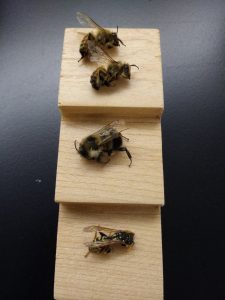
Insects will be pinned after collection
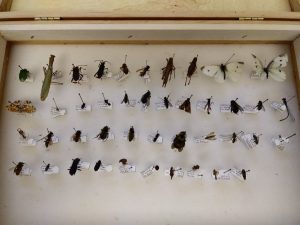
A collection will be made with caught specimens
With the creation of the reference collection, upon catching a bee I may be able to identify it on-site. After catching a bee, I will place it into a small beaker, contained within a larger beaker with ice in it. The ice contained within the beaker will act to slow the movement of the bee enough to allow for careful observation of the specimen. Once slowed enough, I will carefully observe the bee within the container and will refer to my reference collection. If the species of the particular specimen is present within my collection, I will identify the bee and release it back into the garden. If I do not have the species of the bee already within my collection or I do not feel confident enough in my observation to accurately identify it on-site, I will need to place the bee into a killing jar (or a little beaker of ethanol that will kill it instantly) and store it in a cooler to be brought back to the lab for further examination prior to identification.
In addition to the use of sweep nets to collect bee specimens, I will be placing a series of pan traps at each of the locations. These traps will consist of a series of plastic bowls filled with a mixture of water and dish soap. The traps are to be coloured, white, yellow and blue, which have been shown to be some of the most effective colours in attracting bees to these traps (Grundel et al, 2011). If a bee is attracted to a trap, it may try to land in it, in which case it will get trapped in the soapy water once contact is made and will drown. A set number of these traps will be placed at each site, and will need to be located in an exposed area of the garden where bees are more likely to see them (Droege, 2008). The exact number, arrangement and colour of the traps will be dependent on the size of the transect to be sampled from across sites. Specimens from the traps will be collected by dumping the contents of the trap into a sieve, which will act like a strainer and leave behind only the specimens. The non-bee insects and debris will be removed and the bees will be placed into a whirl-pak. The water in the traps will need to be replaced and additional soap will need to be added quite regularly, preferably after each time I check the traps. This will be done to ensure that the traps are adequately charged to most effectively collect bees. For species that I am unable to identify through that method, I will have to contain them within a killing jar for later identification in the lab.
To retain a consistent sampling method across all sites, sampling will only take place on clear days with little wind and a reasonably high temperature, between the times of 9:00 to 4:00. It will occur for 30 minutes at each site. The sampling of bees during these times of the day will restrict the sampling period to times where bees will be most abundant.
Measures of bee diversity and abundance will be recorded mostly in-field. The overall number of bees seen passing through a transect over the specified collection period will be recorded as a measure of abundance, however measures of diversity will depend on the number of individual species seen within a transect. Some of the species will be able to be recorded in field with the help of the reference collection, however specimens identified in-lab will also contribute to these measures.
Note: The ideas and methods described above are preliminary and are subject to change as further development of my research plan occurs.
Acknowledgements
Dr. Jason Pither- Supervisor
Dr. Bob Lalonde- Committee Member
Dr. Lael Parrott- Committee Member
Nancy Holmes- Committee Member and co-head of Border Free Bees
References
Bates, A. et al. (2011). Changing Bee and Hoverfly Pollinator Assemblages along an Urban-Rural Gradient. PLoS ONE. 6(8): e23459.
Border Free Bees. (2015). Border Free Bees. Retrieved from: http://borderfreebees.com/
Border Free Bees. (2017). Kelowna Nectar Trail Project. Retrieved from: http://borderfreebees.com/kelowna-nectar-trail/
Border Free Bees. (2018). Kelowna Bee Ambassador Project. Retrieved from: http://borderfreebees.com/2018-kelowna-bee-ambassador/
Droege, S. (2008). The Very Handy Manual: How to Catch and Identify a Bee.
Environmental Youth Alliance. (2013). Planning for Urban Pollinators. http://eya.ca/wp-content/uploads/2015/05/Planning-for-Pollinators-Report-web-version1.pdf
Gill, R.J. et al. (2016). Protecting an ecosystem service: approaches to understanding and mitigating threats to wild insect pollinators. Advances in Ecological Research (2016). 54: 135-206.
Grundel, R. et al. (2011). Effectiveness of Bowl Trapping and Netting for Inventory of a Bee Community. Environmental Entomology. 40(2): 374-380.
Hall, D.M. et al. (2017). The city as a refuge for insect pollinators. Conservation Biology. 31(1): 24-29.
Hennig, E.I. and Ghazoul, J. (2012). Pollinating animals in the urban environment. Urban Ecosystems. 15(1): 149-166.
Kearns, C.A. and Oliveiras, D.M. (2009). Environmental factors affecting bee diversity in urban and remote grassland plots in Boulder, Colorado. Journal of Insect Conservation. 13(6): 655-665.
McFrederick, Q.S. and LeBuhn, G. (2006). Are urban parks refuges for bumble bees Bombus spp. (Hymenoptera: Apidae)? Biological Conservation. 29(3): 372-382.
Pardee, G.L. and Philpott, S.M. (2014). Native plants are the bee’s knees: local and landscape predictors of bee richness and abundance in backyard gardens. Urban Ecosystems. 17(3): 641-659.
Potts, S.G. et al. (2010). Global pollinator declines: trends, impacts and drivers. Trends in Ecology and Evolution. 25(6): 245-353.
Somme, L. et al. (2016). Food in a row: urban trees offer valuable floral resources to pollinating insects. Urban Ecosystems. 19(3): 1149-1161.
Tommasi, D. et al. (2004). Bee diversity and abundance in an urban setting. The Canadian Entomologist. 136(6): 851-869.
Wratten, S.D. et al. (2012). Pollinator habitat enhancement: Benefits to other ecosystem services. Agriculture, Ecosystems & Environment. 159(2012): 112-122.
